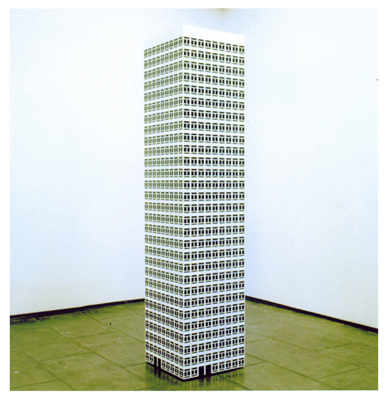| Julian Opie Modern Tower 8, 2002 |
| Sculpture | Vinyl and paint on black wood |
| 242.3 x 53.6 x 53.6 cm |

|
Julian Opie’s sculpture follows the same aesthetic and conceptual criteria as his two-dimensional work. Minimalist compositions dominated by schematic, mechanical, impersonal lines, graphic – in this case volumetric – solutions close to the pictogram, the computer drawing or the virtual image. Following the architectural regularity of the tower and on the basis of rectangular wooden cubes of different heights, he constructs perfect buildings with wefts of lines which, from the repetition of constant motifs (in this case absolutely geometrical windows), reveal an urban micro-architecture. As with his landscapes, objects or portraits, his solutions respond to certain stereotypes of building and, in short, characteristic, recognisable town planning models. Opie’s towers, whether on show in galleries or in the public space – where they are enriched by their exchange with the exterior –, invite a specific look at reality, the world around them and its regulated, coded system of relations. Close to the purity of minimal art, but sensitive to the imagery of pop – or rather neo-pop or post-pop – culture, his Modern Towers go beyond any aesthetic exercise in geometrical simplification and provide a reading of certain elements which resembles the seduction of advertising, such as these hermetic skyscrapers that become direct symbols of contemporary city life, perhaps from the most stereotyped and clichéd version of the American city and the vertical domain. The simplicity of forms, lines and colours that is such a feature of Opie’s work, and which has made him famous precisely for his construction of artificial realities, in other words, for a specific vision of the world half way between the real and the virtual, is transferred here to the volume of the sculpture. Nevertheless, the purity of lines, the rigour and the geometrical obsession of the Modern Towers often recall a perception closer to virtual reality systems, with sensations of false perspective or a certain spatial illusion (resources which are also common in his work as a whole). In addition to these models of buildings, in which he reproduces some of the basic schemata of modern architecture, which have now become the typical skyline of the contemporary city (we need only think of the image we all have of New York), he shows other architectural models in the towers series, such as the Baroque Towers, the Gothic Towers or the Tourist series, in which he mixes different buildings to offer a chaotic image of the modern city, a fragmented and confused perception typical of the tourist approach to the places we visit but do not live in. David Armengol |

